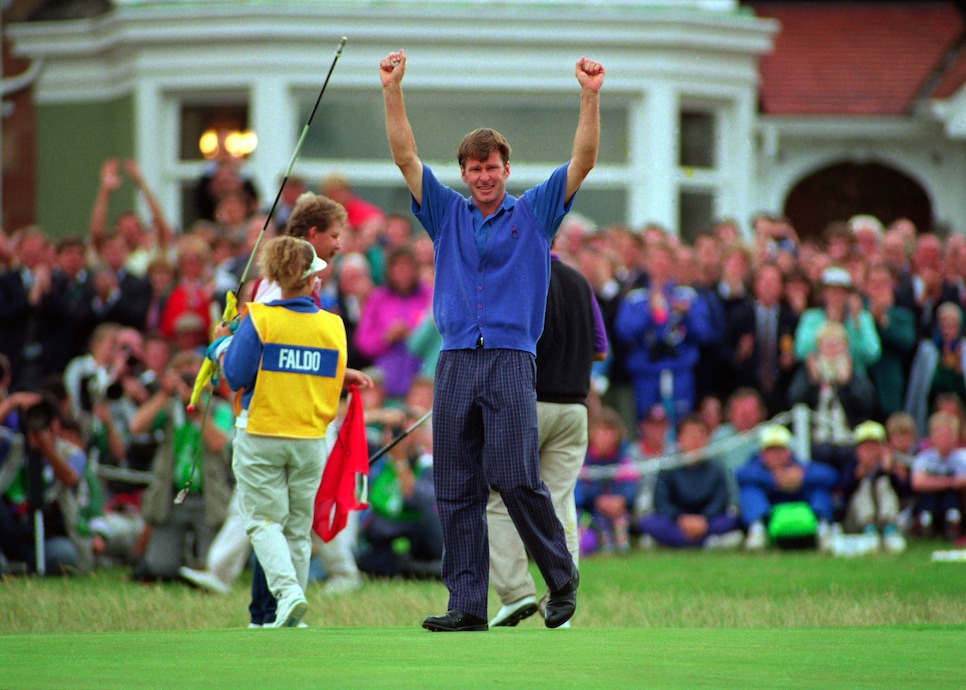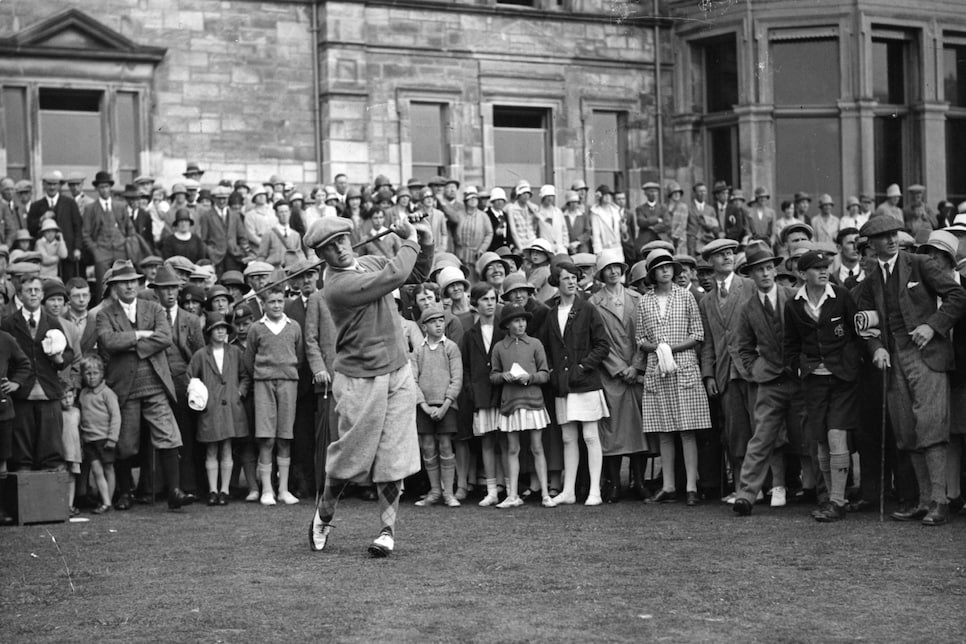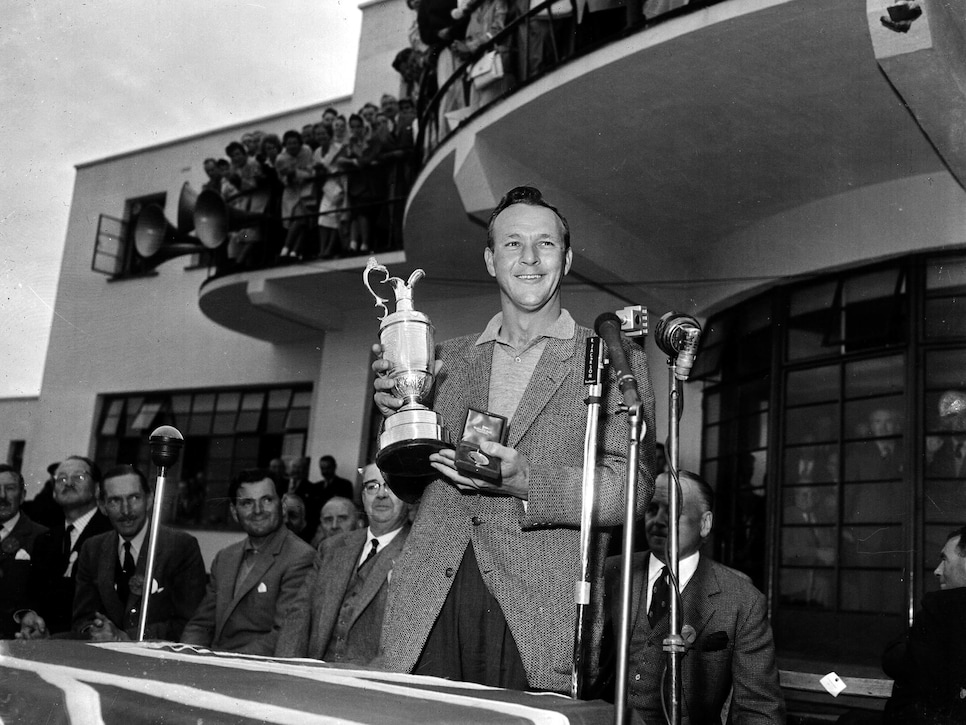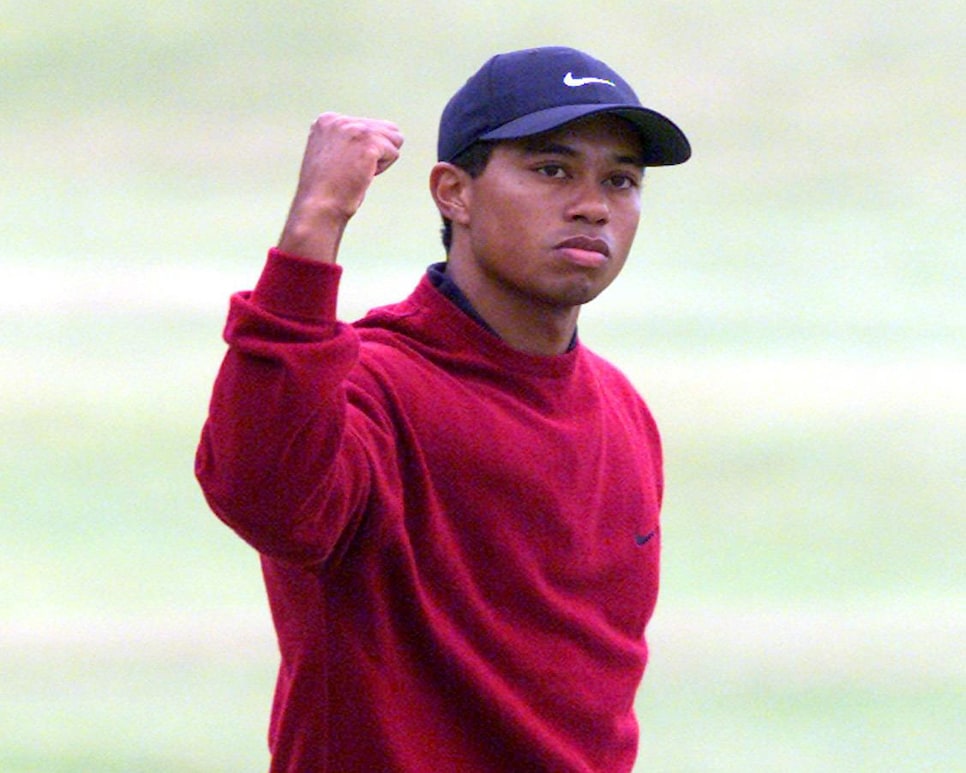[PHOTO: Mark Runnacles]
Back in the COVID year of 2020, we enlisted the help of R&A senior curator Laurie Rae to tackle the huge job of ranking the best 15 Open Championships ever. It was a bit of solace in a July when The Open had been cancelled, but luckily, we’re back on track with the 153rd Open, to be held at Royal Portrush, right around the corner. (Knock on wood… if another global pandemic happens in the meantime, you can blame us for the jinx.)
RELATED: The major that never happened – the story behind the cancellation of the 2020 Open Championship
Today, we’re taking a hard look at the work of five years ago, and updating it where necessary, especially to account for a very good, very dramatic Open that has happened in the interval. We didn’t consult Mr Rae this time around, but large amounts of this work still owe everything to his wisdom, and the errors and omissions are entirely ours. Let’s do it!
Honourable Mention: 1954, Peter Thomson, Royal Birkdale
If there are two historical golfers who merit more global attention than they get, they are our own Peter Thomson and South African Bobby Locke. Rae didn’t want to use the word “forgotten”, but I will. At least in America, Thomson and Locke don’t get the credit they deserve, possibly because neither took home an American major and possibly because they missed the early peak of televised golf. But for a period in the 1950s, they were dominant at The Open, winning eight of 10 claret jugs between 1949 and 1958. The ’54 Open saw Thomson claim the first of his five and become the first Australian to capture the championship. He and Locke were among those who fought it out in the final round at Royal Birkdale, and though I couldn’t find footage of Thomson’s sand recovery on 16, I did find this delightful newsreel showing the action of the final holes:
15. 1937, Henry Cotton, Carnoustie
Cotton’s triumph in 1934 was critical because it broke a streak of eight straight American wins, but his victory in ’37 was even more important in that he defeated the entirety of the US Ryder Cup team, all of whom had stuck around to play at Carnoustie after their 8-4 win in late June. Cotton’s brilliant final-round 71 came in torrential conditions, and he later said that it was one of the finest rounds of his career. With that result, he overcame a three-shot 54-hole deficit to defeat among others Byron Nelson. According to Rae, the Englishman’s win “maintained British interest in the championship itself”.
14. 1992, Nick Faldo, Muirfield 
Photo: Getty Images
As Rae noted, Faldo was in the prime of his prime, going for his fifth major in six years. He had won the Irish Open, and at the start of this Open, he looked fundamentally unstoppable. He set a 36-hole record, beat his own 54-hole record and came into the final round leading by four shots. It looked like a coronation, but it was not – a miserable stretch of holes from 11 to 14 saw him lose three shots, American John Cook catching him and taking the lead on 16. For Faldo, this “dominant” Open now became about resilience. Pulling himself together, he birdied two of the final four holes and squeaked out a one-shot win after Cook missed a tiny birdie putt on 17 then bogeyed the 18th – a testament to perseverance and even acceptance in the face of what must have been huge disappointment, and the greatest of his three Opens.
13. 1927, Bobby Jones, Old Course at St Andrews 
Photo: Topical Press Agency
In 1921, a younger, more impetuous Bobby Jones became so angry at his play in the third round at St Andrews that he tore up his scorecard and withdrew after 11 holes. He then insulted the Old Course, and the St Andrews press fired back, writing “Master Bobby is just a boy, and an ordinary boy at that.” This, then, was a kind of comeback story, because in the interval, Jones had come to love both the course and the town. And as fate would have it, they loved him back. When he won by six shots, he was carried off the green by a jubilant crowd, and even asked that his trophy be kept in Scotland with the R&A. By 1958, Jones had become just the second American “Freeman of the City” in St Andrews, an honour he shared with none other than Ben Franklin. At that ceremony, Jones said of the Old Course that, “the more you study it, the more you love it, and the more you love it, the more you study it.”
12. 1953, Ben Hogan, Carnoustie
What do you call it when the greatest golfer of his generation comes over for the first and only time in his life, had just a week to prepare for the links style, improved in every round and won by four strokes? You call it Ben Hogan being Ben Hogan. The win capped an incredible year in major championships that also saw him capture the Masters and US Open. He remains the only golfer to ever win those three events in the same year.
11. 2022, Cameron Smith, Old Course at St Andrews
When it came time to decide whether we should include any of the past five Opens in the updated ranking, one stood out above the others – Smith’s triumph over Rory McIlroy at St Andrews. For fans of McIlroy and the traditional world of golf, this was an absolute heartbreaker, because Rory at the time represented what you might call the anti-LIV faction, while it became clear even before his victory was secured that Smith was on his way to LIV. Throw in the fact that this was the 150th Open, and that McIlroy was trying to break his ongoing major drought in what would undoubtedly be the most poetic way possible, and you had an unbelievably tense and riveting final round. In the end, though, the gritty Aussie was spectacular, beating McIlroy by six strokes in the last round, and the highlight of his pressure-packed win came with this gutsy putt around the bunker at the 17th hole:
'Oh my goodness'
Cam Smith with nerves of steel 👏#The150thOpen pic.twitter.com/DQ3atZKXTY
— The Open (@TheOpen) July 17, 2022
10. 2019, Shane Lowry, Royal Portrush
We had this one ranked No.2 in 2020, and were probably guilty of a bit of recency bias. Rae’s argument at the time was that The Open, more than any other major, is about history, and the significance of holding the first Northern Irish Open since 1951 is about as historical as it gets. In the interlude, the country fell into decades of religious and political conflict, and the symbolism of the R&A returning to Royal Portrush was enormous, particularly at a time when trouble seemed to loom once again with Brexit movements on the horizon. To pull off a safe event, embraced by the people, and for an Irish golfer to win… well, it didn’t matter that the final day lacked drama. This belongs close to the top. “It made your heart beat quicker to witness it,” Rae told me, and in the end, I agreed with him – the historical importance is vast. We’re dropping it a few spots in the ranking this time around due solely to the lack of final-round drama, but that historical import hasn’t dimmed a bit in the intervening years.
9. 1984, Seve Ballesteros, Old Course at St Andrews
I’ll be honest: I’m in this one for the little dance Seve did when he sunk his putt on the 72nd hole. But historically, it merits top-10 status for the incredible drama at the end. Tom Watson, heading into the final round tied for the lead, had one of his greatest chances to win what would have been his record-tying sixth Open. With two holes to play, Watson and Seve were tied. Seve had a putt to take the lead on 18, while Watson was struggling to make his par on the Road Hole. The drama can best be seen starting at the 44:30 mark here:
Seve’s putt instigated a two-shot swing, perhaps one of the most famous in major championship golf, and added his name to the list of legendary winners at the Home of Golf.
8. 1896, Harry Vardon, Muirfield
This was the first of Vardon’s record six Open Championship wins, and though Rae said that every one of them was noteworthy enough to merit inclusion on the list, this one stood out because of how Vardon out-duelled his great rival J.H. Taylor over a 36-hole playoff. While the tournament’s final round came on a Thursday, the playoff wasn’t played until Saturday, since both Vardon and Taylor had to play a different 36-hole tournament on the Friday. Taylor won that one, but Vardon beat him at Muirfield. Taylor would win again, though, and in fact there was a 21-year period when Vardon, Taylor and James Braid won 16 championships between them. “They were the superstars of The Open,” Rae said.
7. 1868, Tom Morris Jnr, Prestwick
At the time, Tom Morris Jnr (if you’re wondering, yes, I was slightly disappointed that Rae didn’t call him “Young Tom Morris”) was the youngest player in Open Championship history at 17. Prestwick was a 12-hole course, and the three rounds of the championship were all held on a single day. Morris Jnr set a record when he shot 51 on his first round, which was then bested by his father, who shot a 50 in the second round to take a one-shot lead. In the final round, though, Morris Jnr struck back, carding a 49 to beat his dad by three shots and win his first Open (which came with a huge £6 prize). This was the first of four straight Opens victories for Young Tom. As Rae pointed out, his story is all the more poignant because of his untimely death – Morris Jnr died on Christmas Day 1875 at age 24 from a pulmonary haemorrhage. “There were often very few competitors at this time,” Rae said, “but the golf was no less impressive and the champions no less dominant than they are today.” Morris Jnr remains the youngest Open winner in history, and his father is still the oldest.
6. 1972, Lee Trevino, Muirfield
In terms of the greatest shots in Open history, Trevino’s chip-in at the 17th hole on Sunday ranks near the top. He had bungled the par 5 up to that point, and had to hole out for par while Tony Jacklin, tied for the lead, had a 15-footer for birdie. It looked very much like Jacklin would head to the final hole with at least a one-shot edge. “I really felt, on the 17th, like I’d broken him,” Jacklin would later say. But in one of the great feats of matchplay-within-strokeplay golf, Trevino turned the tables. Watch it play out, including Jacklin’s subsequent putts, starting at the 3:45 mark:
For Jacklin, who had watched Trevino hole out twice the day before, the loss was unbearable. Later, he said, “I was never the same again after that. I didn’t ever get my head around it – it definitely knocked the stuffing out of me somehow.” Jacklin had already won The Open in 1969, luckily, and would go on to transform the European Ryder Cup team as its captain, but what shows the emotional swings of golf better than that moment, which gave Trevino his second straight claret jug?
5. 1961, Arnold Palmer, Royal Troon 
Photo: Bob Thomas
The impact here was more wide-ranging than any drama on the course, in which Palmer beat Dai Rees by a shot. What really mattered was that Palmer was the first American champion since Hogan in 1953, and his win did more to increase the status of The Open in America than anything before. According to Rae, a figure as beloved as Palmer, who believed so much in the history and importance of The Open as the oldest of the majors – this was his second trip over, having finished runner-up to Australia’s Kel Nagle in ’60 – and who wanted to win it so badly, fundamentally changed how the tournament was viewed in the eyes of American professionals. Many had stopped making the trip due to travel concerns, the low prizemoney and various other reasons. Palmer’s victory completely changed the perception. You can see it in the results – the long American dry spell was over, and in the 60 Opens that started with his win, Americans have won more than half. In his unique way, Palmer made it matter again.
4. 1970, Jack Nicklaus, Old Course at St Andrews
It seems like the great ones always manage to get a win at St Andrews, and for Nicklaus, this was the first of two. Interestingly, Doug Sanders only needed a par on the 18th hole to pull out the victory, but he missed a three-foot putt after being distracted by something in his eyeline. Despite Sanders’ disappointment, he battled hard in the 18-hole playoff. It came down to the 18th hole, where Nicklaus took off his yellow sweater and hit one of the most famous shots of his career – a drive that actually bounded over the green, travelling about 360 yards in total.
He chipped close from there, made his birdie putt and beat Sanders by one. At the end of this video, you can see Nicklaus, thrilled beyond self-control when his winning putt caught the right and edge and fell, actually threw his putter in the air, which nearly managed to hit Sanders as it fell.
3. 2016, Henrik Stenson, Royal Troon
“Some of the finest links golf you’d ever seen,” Rae said, and really, what more needs adding to this incredible fight between Stenson and Mickelson? It ended with Mickelson cooling off, just slightly, but Stenson never did, tying Johnny Miller’s major record (for a winner) with a final-round 63, and set a cumulative Open record with his 72-hole score in relation to par of 20-under. In many ways, it was also the best possible result – Mickelson had already won his Open in 2013, and Stenson was a player who deserved a major, but was starting to look like he might never get one. To win the Open, as a European, felt appropriate, and secured Stenson’s legacy. Plus, there was that record-setting final putt:
2. 2000, Tiger Woods, Old Course at St Andrews 
Photo: Jonathan Utz
It seems like every major has its quintessential Transcendent Tiger year, in which the GOAT demolishes the field in ways that defy belief. The Masters in 1997, the US Open in 2000, and maybe, at a stretch, the 2006 PGA. For the Open Championship, it was back in the greatest year of his great career, 2000. This was the “Millennium Open”, at the most famous course in the world, and 239,000 spectators watched him post a then-Open record score of 19-under, beating his nearest opponent by eight strokes and securing the career Grand Slam at the age of 24, the youngest to achieve the feat. Rae reminded me of an incredible facet of his performance: in 72 holes of superb course management, he didn’t find a single bunker. Remarkable anywhere, but especially at St Andrews. And it’s also worth remembering that coming on the heels of his crushing Pebble Beach win, it legitimately seemed like Tiger might never lose again. This was a kind of dominance we’d never seen before, and haven’t since.
1. Tom Watson, 1977, Turnberry
Students of the game knew No.1 without having to scroll down, or else would have been enraged to find anything else in the top spot. “The Duel in the Sun” between Watson and Jack Nicklaus was simply one of the greatest golf spectacles ever, and one that, to quote Rae, “will forever be spoken about.” It was about the great rivalry between the two men, it was about the sportsmanship on display, and, of course, it was about the golf. “It went beyond natural chronology,” Rae said. “It was legendary.”
Watson, 27, and Nicklaus, 37, matched each other score for score in the first three rounds at Turnberry, which was hosting The Open for the first time, pulling away together where by the end, they were 10 shots better than anyone else in the field. There was a torrid closing stretch, where Watson birdied four of the final six holes for the dramatic victory, but perhaps it’s best summarised by a quote from that final-round Saturday, when Watson turned to Nicklaus and said, “This is what it’s all about, isn’t it?”
“You bet it is,” Nicklaus replied.




